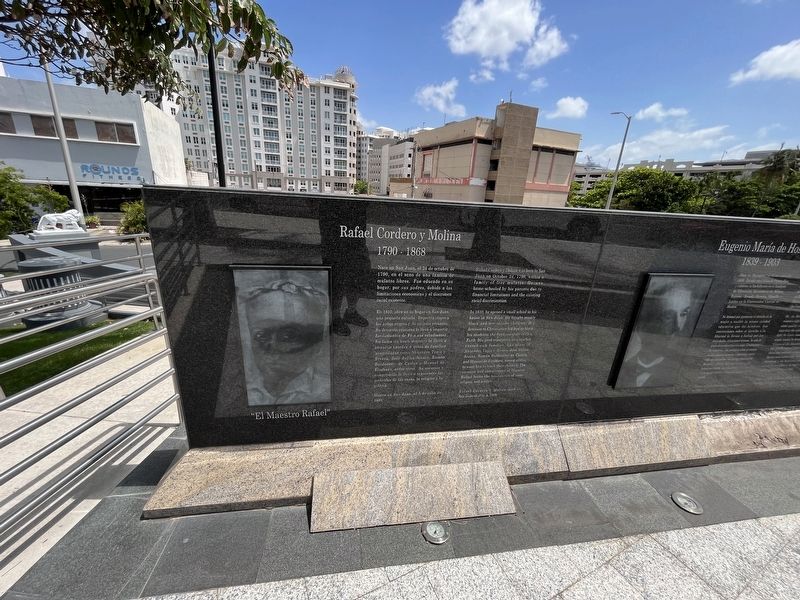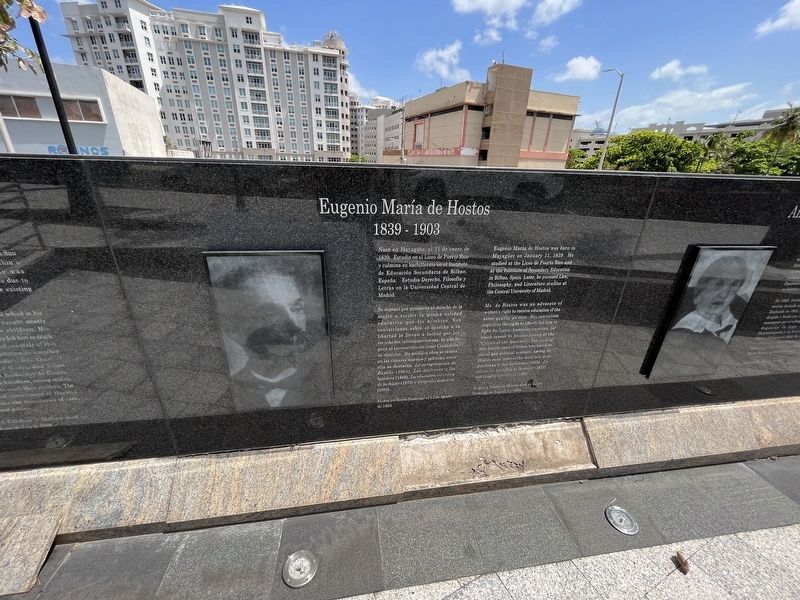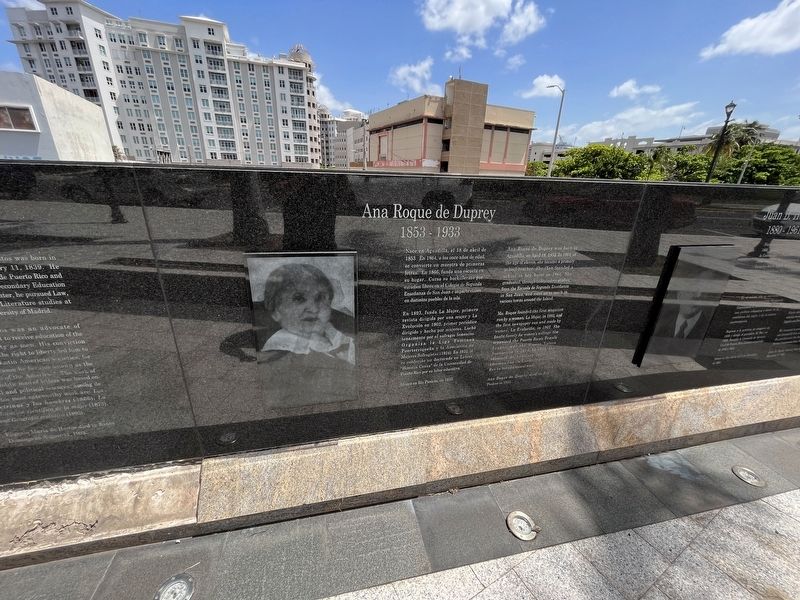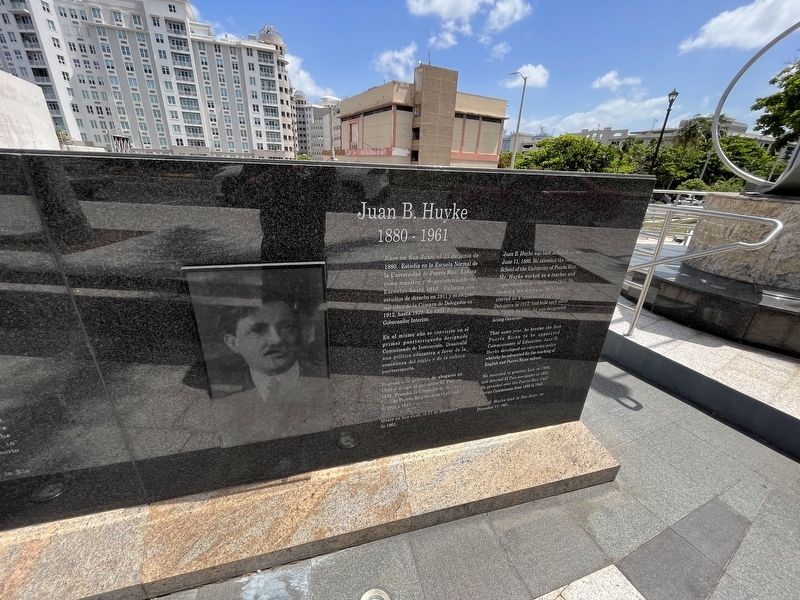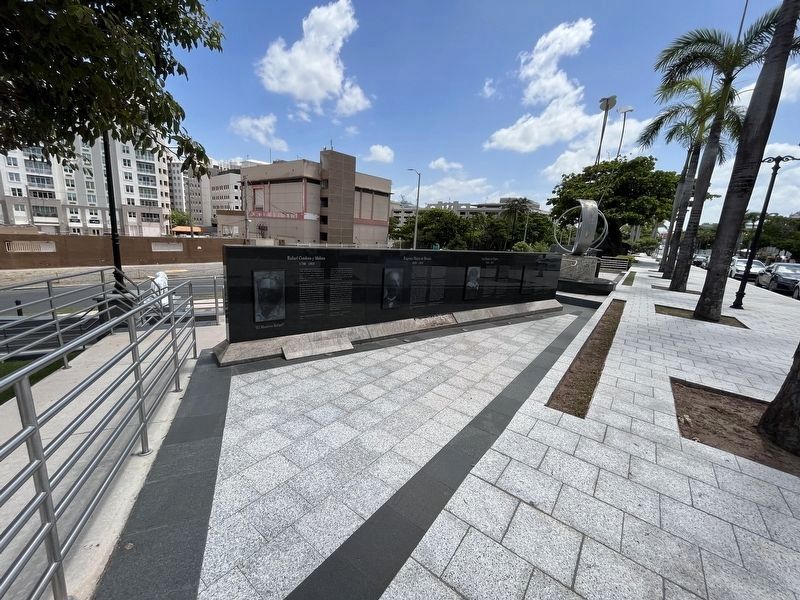Puerta de Tierra in San Juan in Municipio de San Juan, Puerto Rico — The Caribbean (The West Indies)
Rafael Cordero y Molina / Eugenio María de Hostos / Ana Roque de Duprey / Juan B. Huyke
1790 - 1868
"El Maestro Rafael"
En 1810, abre en su hogar en San Juan, una pequeña escuela. Impartía clases a los niños negros y de escasos recursos. Su devoción cristiana le llavó a imparir fundamentos de Fé a sus estudiantes. Su fama de buen maestro le llevó a impartir cátedra a niños de familias acomodadas como AlejandroTapia y Rivera; José Julian Acosta. Ramón Baldorioty de CAstro y Manuel de Elzaburu, entre otros. Su vocación y compromiso le llevó a trascender los umbrales de las razas, la religión y la política.
Muere en San Juan, el 5 de julio de 1868.
In 1810, he opened a small school in his house in San Juan. He taught mostly black and low-income children. His devotion to Christianity led him to teach his students the fundamentals of this Faith. His good reputation as a teacher caused rich families, like those of Alejandro Tapia y Rivera, Jose Julián Acosta, Román Baldorioty de Castro, and Manuel de Elzaburu, among others, to want him to teach their children. The vocation and commitment of Maestro Rafael broke the boundaries of race, religion, and politics.
Rafael Cordero y Molina died in San Juan on July 5, 1868.
1839 - 1903
Se destacó por promover el derecho de la mujer a recibir la misma calidad educativa que los hombres. Sus convicciones sobre el derecho a la libertad le llevan a luchar por las sociedades latinoamericanas, lo que le gana el reconocimiento como Ciudadano de América. Su prolifica obra se centra en las ciencias morales y políticas, entre ella se destacan: La peregrinación de Bayoán (1863), Las doctrinas y los hombres (1866), La educación científica de la mujer (1873) y Geografía evolutiva (1895).
Muere en Santo Domingo el 11 de agosto de 1903.
Mr. de Hostos was an advocate of women's right to receive education of the same quality as men. His conviction regarding the right to liberty led him to fight for Latin American societies, for which reason he became known as the "Citizen of the Americas." The work of this prolific man of letters was based on moral and political sciences; among de Hostos most noteworthy work are: Las doctrinas y hombres (1866), La educación científica de la mujer (1873), and Geografía evolutiva (1895).
Eugenio María de Hostos died in Santo Domingo on August 11, 1903.
1853 - 1933
En 1893, funda La Mujer, primar revista dirigida por una mujer y La Evolución en 1902, primer periódico dirigido y hecho por mujeres. Luchó tenazmente por el sufragio femenino. Organizada la Liga Femínea Puertorriqueña y la Asociación de Mujeres Sufragistas (1924). In 1932, le es conferido un doctorado en Letras "Honoris Causa" de la Universidad de Puerto Rico por su labor educativa.
Muere en Río Piedras, en 1933.
Ms. Roque founded the first magazine run by a woman, La Mujer, in 1893, and the first newspaper run and made by women, La Evolución, in 1902. She fought fiercely for women's suffrage. She organized the Puerto Rican Female League, and the Women Voters Association in 1924. In 1932, she obtained an honorary degree in Literature from the University of Puerto Rico for her educational work.
Ana Roque de Duprey died in Río Piedras in 1933.
1880 - 1961
En el mismo año se convierte en el primer puertorriqueño designado Comisionado de Instrucción. Desarrolló una policia, educativa a favor de la enseñanza del inglés y de la cultura puertorriqueña.
Regresa a la práctica de abogacía en 1930 y dirige el periodico El País en 1932. Presidió la Comisión de Servicio Civil de Puerto Rico durante el periodo de 1935 a 1945.
Muere en San Juan, el 17 de diciembre de 1961.
That same year, he became the first Puerto Rican to be appointed Commissioner of Education. Juan B. Huyke developed an education policy whereby he advocated for the teaching of English and Puerto Rican Culture.
He returned to practice Law in 1930, and directed El País newspaper in 1932. He presided over the Puerto Rico Civil Service Commission from 1935 to 1945.
Juan
B. Huyke died in San Juan, on December 17, 1961.
Topics. This historical marker is listed in these topic lists: African Americans • Arts, Letters, Music • Churches & Religion • Civil Rights • Communications • Education • Government & Politics • Industry & Commerce • Women. A significant historical date for this entry is July 5, 1868.
Location. 18° 27.966′ N, 66° 6.404′ W. Marker is in San Juan in Municipio de San Juan, Puerto Rico. It is in Puerta de Tierra. Marker is on Avenida de la Constitución (Puerto Rico Route 25) west of Calle Reverendo Gerardo Dávila, on the right when traveling east. Touch for map. Marker is at or near this postal address: Avenida de la Constitución 155, San Juan PR 00901, United States of America. Touch for directions.
Other nearby markers. At least 8 other markers are within walking distance of this marker. Desarrollo de la Educación en Puerto Rico (a few steps from this marker); Lolita Tizol Laguardia / Concha Meléndez / Pilar Barbosa de Rosario / Margot Arce de Vázquez (a few steps from this marker); Helena Blaszczyk (a few steps from this marker); Kira Belkova (a few steps from this marker); The Kolkowska Family (a few steps from this marker); Oskar Schindler (a few steps from this marker); Miep Gies (a few steps from this marker); Frieda Adam (a few steps from this marker). Touch for a list and map of all markers in San Juan.
Credits. This page was last revised on June 17, 2023. It was originally submitted on June 17, 2023, by Devry Becker Jones of Washington, District of Columbia. This page has been viewed 68 times since then and 8 times this year. Photos: 1, 2, 3, 4, 5. submitted on June 17, 2023, by Devry Becker Jones of Washington, District of Columbia.
